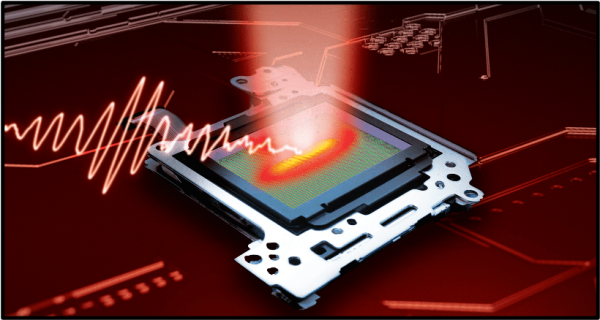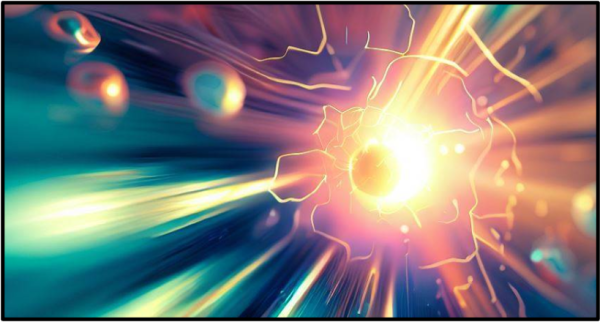Lightwave Electronics and Attosecond Photonics
Research in the LEAP group is broadly focused on measuring ultrafast electronic processes in atoms, molecules, and solids which are triggered by absorption of high-frequency photons and/or driven by the electric field of low-frequency light.
Since the motion of electrons occurs on characteristic time scales of femtosecond to attoseconds (characteristic frequency scales of petahertz to exahertz), measuring and controlling electron dynamics requires ultrashort pulsed lasers and ultrafast time-resolved spectroscopic techniques capable of reaching these extremes.
We subdivide our research focus into two thrusts, Lightwave Electronics and Attosecond Photonics as described below.
Lightwave Electronics

Modern electronics is based on the ability to generate, manipulate, and measure charge currents on nanosecond time scales.
Improved competencies in these areas has been critical to increasing the switching speed of transistors from the ~100 MHz level in the 1950s to the ~100 GHz level today.
In lightwave electronics, we aim to develop advanced capabilities in the generation, manipulation, and measurement of optical pulses and laser-driven charge fluctuations and currents, which can eventually be translated into new device technologies.
We leverage recent advances in several critical areas to achieve these goals:
- Developing new laser technologies to generate few-cycle laser pulses in novel spectral ranges, including the mid-infrared
- Using advanced nonlinear optical techniques to convert laser frequencies and generate ultra-broadband laser pulses with frequency spectra covering multiple octaves
- Applying optical field synthesis to generate sub-cycle field transients and arbitrary optical waveforms
- Characterizing the electronic response of molecular and solid-state systems to the synthesized pulses using a combination of attosecond transient absorption, high-order harmonic spectroscopy, and field-resolved optical spectroscopy
- Journigan, T., Liu, Y., Cabello, C., Berriel, S. N., Banerjee, P. & Chini, M. “High harmonic generation in epitaxially grown zinc oxide films.” J. Opt. Soc. Am. B 41, B1-B6 (2024).
- Truong, T.-C., Beetar, J. E. & Chini, M. “Light-field synthesizer based on multidimensional solitary states in hollow-core fibers.” Opt. Lett. 48, 2397-2400 (2023).
- Alam, D., Ud-Din, N., Chini, M. & Turkowski, V. “Electron-Electron Interactions and High-Order Harmonics in Solids.” Phys. Rev. B 106, 235124 (2022).
- Liu, Y., Beetar, J. E., Nesper, J., Gholam-Mirzaei, S. & Chini, M. “Single-shot measurement of few-cycle optical waveforms on a chip” Nature Photon. 16, 109-112 (2022).
Attosecond Photonics

Laser-based sources of attosecond pulses, for which Anne L’Huillier, Pierre Agostini, and Ferenc Krausz shared the 2023 Nobel Prize in Physics, can be produced through high-order harmonic generation (HHG) of an infrared laser source in an atomic gas medium.
Subsequent advances in HHG, along with the underlying laser technology, have enabled new spectroscopic tools for studying ultrafast electron dynamics in atoms, molecules, and solids.
However, ultrafast science applications demand attosecond sources with higher peak power, higher average power, and broader spectral coverage than what can currently be achieved.
In attosecond photonics, we aim to develop advanced lasers and attosecond HHG sources which can enable solutions to grand scientific challenges.
Our efforts in this area are focused in two specific directions:
- in Electron DynamIX (Electron Dynamics with Intense X-rays), we aim to develop HHG-based sources of attosecond pulses in the soft x-ray region of the spectrum, with sufficient intensity to serve as both the pump and probe pulses in a time-resolved experiment.
- Realizing intense x-ray attosecond pulses will enable element-specific excitation and probing of charge coherences in extended molecules, as well as nonlinear spectroscopy of electron dynamics on solid surfaces and interfaces
- Realizing intense x-ray attosecond pulses will enable element-specific excitation and probing of charge coherences in extended molecules, as well as nonlinear spectroscopy of electron dynamics on solid surfaces and interfaces
- in RelATIν (Relativistic Attosecond Transients at Infrared Frequencies), we aim for dramatic increases in the peak power levels that can be achieved from synthesized attosecond optical pulses, to realize relativistic laser-matter interactions on attosecond time scales and to potentially exceed the current limits of laser peak intensity
- Truong, T.-C., Beetar, J. E.* & Chini, M. “Light-field synthesizer based on multidimensional solitary states in hollow-core fibers.” Opt. Lett. 48, 2397-2400 (2023).
- Beetar, J. E.*, Nrisimhamurty, M., Truong, T.-C., Liu, Y. & Chini, M. “Thermal Effects in Molecular Gas-Filled Hollow-Core Fibers.” Opt. Lett. 46, 2437 (2021).
- Beetar, J. E.*, Madugugula, N. M., Truong, T.-C., Nagar, G. C., Liu, Y., Nesper, J., Suarez, O., Rivas, F., Wu, Y., Shim, B. & Chini, M. “Multi-Octave Supercontinuum Generation and Frequency Conversion based on Rotational Nonlinearity.” Sci. Adv. 6, eabb5375 (2020).
